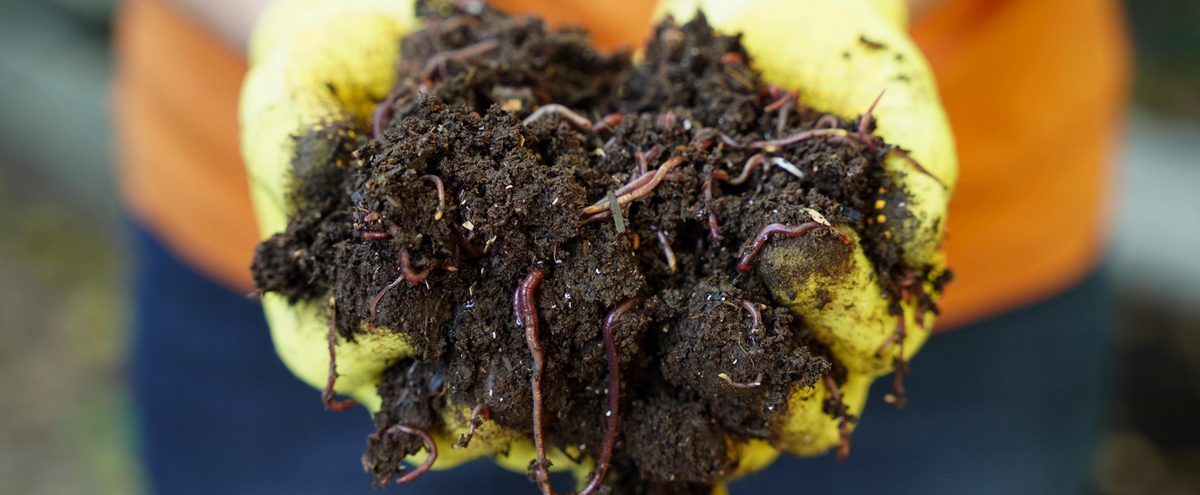
Composting on your farm
Composting is a powerful tool for land managers looking to enhance soil health and support plant growth. By transforming organic waste into nutrient-rich compost, you can improve soil structure, promote beneficial microbes, and reduce the need for synthetic fertilisers.
While composting may seem simple, achieving high-quality compost requires attention to detail and understanding the science behind it.
On this page:
Composting methods
- Worm composting: (vermicomposting): where worms, are used to break down food scraps and other organic materials.
- Static composting: where organic material is piled up and left to break down naturally over time. Unlike other methods, it doesn’t require frequent turning or mixing.
- Thermal composting: where careful management of pile's size, moisture, and airflow, create ideal conditions for microorganisms to thrive, generating heat as they work. This process breaks down materials quickly and kills weed seeds and harmful pathogens. The result is a nutrient-rich compost that promotes plant health and suppresses diseases.
Getting started with thermal composting
Creating a good thermal compost will generally take between 60 to 120 days, depending on conditions and methods used. When starting out it is important to consider the following factors:
Compost ingredients
A successful compost requires a balanced mix of carbon-rich (brown) materials and nitrogen-rich (green) materials. Adding manure can introduce beneficial microbes. The ideal ratio of materials depends on how you plan to use the compost. A soil test at the intended site can help identify the best compost type for your needs.
| Compost Type | Carbon Ratio | Brown Matter | Green Matter | Manure | Best For |
|---|---|---|---|---|---|
| Fungal | High | 45% | 30% | 25% | Perennials |
| Bacterial | Low | 30% | 45% | 25% | Annuals |
Ingredients should be no larger than 50-100mm to maintain air porosity. Finer particles reduce airflow, while larger ones slow decomposition.
Compost pile location
Choose a shaded, protected site that prevents drying out, with easy access to water. Avoid waterlogged areas and ensure the site is free of weeds, away from drainage, and accessible by machinery. If excessive rain is expected, covering the pile may be necessary.
Moisture
Compost should feel moist but not wet when squeezed - around 50-60% moisture content is ideal. Too much moisture can reduce air porosity, while too little will slow decomposition. A spray system can help maintain moisture levels.
Air porosity
Aerobic conditions are essential for rapid decomposition. At least 50% of the compost pile should be air. Turning the pile frequently helps maintain air flow.
Temperature
Compost should reach 45-65°C for effective decomposition. Pile size is critical: windrows should be no higher than 1.5-2 meters and no wider than 2-3 meters. Temperature checks are essential, especially in the first week. If the pile exceeds 68°C, it may cause combustion and reduce compost quality.
To ensure effective pasteurization, the compost pile should reach at least 55°C for three consecutive days to kill pathogens and weed seeds.
Legal considerations
Be mindful of local standards, guidelines and regulations when making compost, including Australian Standards and Environmental Protection Authority (EPA) regulations.
How to know if your compost is ready
After pasteurization, the compost pile should mature at 35-40°C for about 3 weeks, during which large decomposers become active. Turning during this time is unnecessary unless water needs to be added.
A high-quality compost should be dark, crumbly, and free of odor. Biological and chemical tests can assess its value. Amendments like lime or gypsum can be added to adjust pH and nutrient content.
To guide adjustments and improve future processes it can be useful to maintain detailed records of each composting cycle.
Making compost tea

If you have insufficient compost, compost tea can help spread beneficial microbes.
Compost tea is a liquid extract of bacteria, fungi, protozoa, and nematodes from compost. It needs to be brewed and aerated to keep the organisms alive. Compost tea can be applied to pastures and crops to improve soil health, promote growth, and suppress diseases. Use compost tea immediately after brewing (typically within 24 hours) and apply it late in the day or at night.
Compost extract, a lower-level product that doesn't require immediate use, is a water extract from compost. It can be applied with other organic supplements like fish hydrolysate, kelp, or molasses.
Benefits of compost and compost tea
- Adds beneficial organisms to the soil, promoting plant growth and disease resistance.
- Enhances soil structure and nutrient cycling.
- Helps suppress disease-causing organisms.
Compost troubleshooting
| Problem | Cause | Solution |
|---|---|---|
| Excess water runoff | Compost is too wet | Add dry materials or let it dry out |
| Bad smell | Anaerobic conditions | Add larger materials and turn more frequently |
| Ammonia smell | Carbon to nitrogen ratio too low | Add more high-carbon materials |
| Clumping | Compost is too wet | Add dry materials and turn |
| Compost not heating or incomplete | Carbon to nitrogen ratio too high | Add more nitrogen materials, adjust moisture |
| Pile too hot | Excess heat trapped | Reduce pile height, add air |
| Too dry | Lack of moisture | Add water and aerate |
Source dpi.nsw.gov.au
